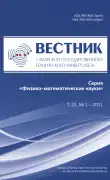Залечивание трещин в пластинах сильным электромагнитным полем
- Авторы: Кукуджанов К.В.1, Левитин А.Л.1, Угурчиев У.Х.2
-
Учреждения:
- Институт проблем механики им. А. Ю. Ишлинского РАН
- Институт машиноведения им. А. А. Благонравова РАН
- Выпуск: Том 25, № 1 (2021)
- Страницы: 193-202
- Раздел: Краткие сообщения
- URL: https://journal-vniispk.ru/1991-8615/article/view/61608
- DOI: https://doi.org/10.14498/vsgtu1831
- ID: 61608
Цитировать
Полный текст
Аннотация
Рассматривается задача о воздействии импульсным высокоэнергетическим электромагнитным полем на краевую трещину в тонкой пластине, воспроизводящая пионерский эксперимент советских ученых по разрушению вершины трещины сильным электромагнитным полем. Численное моделирование осуществляется на основе предложенной электромеханической модели воздействия короткоимпульсным высокоэнергетическим электромагнитным полем на материал с трещиной. Модель учитывает фазовые превращения (плавление и испарение) материала, происходящие в окрестности дефектов, и соответствующие изменения реологии материала в областях этих трансформаций, а также возможность протекания электрического тока между свободными поверхностями трещины (пробоя за счет эмиссии электронов). Все физико-механические характеристики материала считаются зависящими от температуры. Уравнения модели связаны и решаются совместно на подвижной конечно-элементной сетке с применением смешанного метода Эйлера–Лагранжа. Исследуются процессы локализации полей плотности тока и температуры, фазовых превращений (плавления и испарения) в вершине трещины, автоэлектронной и термоэлектронной эмиссии между свободными поверхностями трещины и влияние этих процессов на залечивание трещины. Проводится сравнение результатов моделирования с имеющимися экспериментальными данными по воздействию импульсного поля на краевую трещину в пластине. Полученные в окрестности вершины трещины средняя скорость нагрева металла и градиенты температуры неплохо количественно согласуются с экспериментальными данными. Вдали от трещины, а также на берегах трещины вдали от вершины температура поднималась незначительно. Процесс моделирования воздействия электромагнитным полем, аналогично эксперименту, сопровождается плавлением в вершине трещины, а также испарением металла. Таким образом, при рассматриваемом воздействии током в вершине трещины формируется кратер, который препятствует дальнейшему распространению трещины, приводя к ее залечиванию. Получить аналогичные результаты с помощью ранее предложенных моделей не удавалось.
Об авторах
Константин Владимирович Кукуджанов
Институт проблем механики им. А. Ю. Ишлинского РАН
Email: kconstantin@mail.ru
ORCID iD: 0000-0001-9060-2838
SPIN-код: 1402-1901
http://www.mathnet.ru/rus/person169447
кандидат физико-математических наук; старший научный сотрудник
Россия, 119526, Москва, просп. Вернадского, 101, корп. 1Александр Леонидович Левитин
Институт проблем механики им. А. Ю. Ишлинского РАН
Email: alex_lev@ipmnet.ru
ORCID iD: 0000-0003-2077-8808
SPIN-код: 5367-1314
ResearcherId: J-9511-2013
http://www.mathnet.ru/rus/person30893
ведущий программист
Россия, 119526, Москва, просп. Вернадского, 101, корп. 1Умар Хажбикарович Угурчиев
Институт машиноведения им. А. А. Благонравова РАН
Автор, ответственный за переписку.
Email: umar77@bk.ru
ORCID iD: 0000-0003-2072-6354
SPIN-код: 1828-7089
http://www.mathnet.ru/rus/person169448
научный сотрудник
Россия, 101990, Москва, М. Харитоньевский пер., 4Список литературы
- Finkel V. M., Golovin Yu. I., Sletkov A. A. Disintegration of a crack tip with a strong electromagnetic field, Sov. Phys. Dokl., 1977, vol. 22, pp. 683–685.
- Finkel V. M., Golovin Yu. I., Sletkov A. A. Possibility of braking rapid cracks by pulses of current, Sov. Phys. Dokl., 1976, vol. 21, no. 4, pp. 216–218.
- Kudryavtsev B. A., Parton V. Z., Rubinskii B. D. Electromagnetic and thermoelastic fields in a conducting plate with a cut of finite length, Mech. Solids, 1982, vol. 17, no. 1, pp. 110–118.
- Parton V. Z., Kudryavtsev B. A., Rubinskii B. D. Crack propagation under the action of an electromagnetic field, Dokl. Akad. Nauk SSSR, 1980, vol. 250, no. 5, pp. 1096–1100 (In Russian).
- Cai G. X., Yuan F. G. Stresses around the crack tip due to electric current and self-induced magnetic field, Adv. Eng. Software, 1998, vol. 29, no. 3–6, pp. 297–306. https://doi.org/10.1016/S0965-9978(97)00078-1.
- Cai G. X., Yuan F. G. Electric current-induced stresses at the crack tip in conductors, Int. J. Fract., 1999, vol. 96, no. 3, pp. 279–301. https://doi.org/10.1023/A:1018670829822.
- Liu T. J. C. Effects of temperature-dependent material properties on stress and temperature in cracked metal plate under electric current load, World Academy of Science, Engineering and Technology. Int. J. Mechanical and Mechatronics Eng., 2010, vol. 4, no. 5, pp. 474–479. https://doi.org/10.5281/zenodo.1072134.
- Yu J., Zhang H., Deng D., Hao S., Iqbal A. Numerical calculation and experimental research on crack arrest by detour effect and joule heating of high pulsed current in remanufacturing, Chin. J. Mech. Eng., 2014, vol. 27, no. 4, pp. 745–753. https://doi.org/10.3901/CJME.2014.0414.075.
- Gallo F., Satapathy S., Ravi-Chandar K. Melting and crack growth in electrical conductors subjected to short-duration current pulses, Int. J. Fract., 2011, vol. 167, no. 2, pp. 183–193. https://doi.org/10.1007/s10704-010-9543-0.
- Ovchinnikov I.V. Influence of electric current on the plasticity of metals, PhD Thesis. Moscow, 1989, 123 pp. (In Russian)
- Kukudzhanov K. V., Levitin A. L. Deformation processes of elastoplastic material with defects under electrodynamic loading, PNRPU Mechanics Bulletin, 2015, no. 1, pp. 106–120 (In Russian). https://doi.org/10.15593/perm.mech/2015.1.07.
- Kukudzhanov K.V. Modeling the treatment of high-energy pulsed electromagnetic field of the micro-cracks in a polycrystalline metal, PNRPU Mechanics Bulletin, 2015, no. 4, pp. 138–158 (In Russian). https://doi.org/10.15593/perm.mech/2015.4.09.
- Kukudzhanov K. V., Levitin A. L. Modeling the healing of microcracks in metal stimulated by a pulsed high-energy electromagnetic field. Part I, Int. J. Nanomech. Sci. Tech., 2015, vol. 6, no. 3, pp. 233–249. https://doi.org/10.1615/NanomechanicsSciTechnolIntJ.v6.i3.60.
- Sivukhin D. V. Termodinamika i molekulyarnaya fizika [Thermodynamics and Molecular Physics]. Moscow, Fizmatlit, 2014, 544 pp. (In Russian)
- Pikunov M. V. Plavka metallov. Kristallizatsiia splavov. Zatverdevanie otlivok [Metal Smelting. Alloy Crystallization. The Solidification of Castings]. Moscow, MISiS, 1997, 374 pp. (In Russian)
- Pikunov M. V. Metallurgiia rasplavov. Kurs lektsii [Metallurgy of the Melts. A Course of Lectures]. Moscow, MISiS, 2005, 286 pp. (In Russian)
Дополнительные файлы






